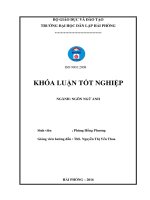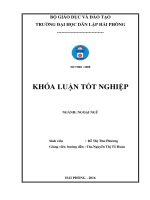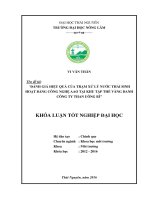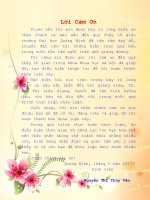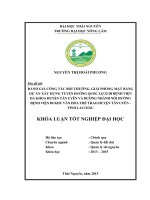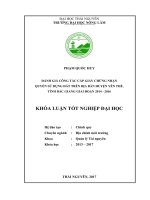Determination of suitable cultural conditions for the growth of black linhzhi mushroom (ganoderma subresinosum) (khóa luận tốt nghiệp)
Bạn đang xem bản rút gọn của tài liệu. Xem và tải ngay bản đầy đủ của tài liệu tại đây (2.67 MB, 75 trang )
VIETNAM NATIONAL UNIVERSITY OF AGRICULTURE
FACULTY OF BIOTECHNOLOGY
UDERGRADUATE THESIS
TITLE:
“DETERMINATION OF SUITABLE CULTURAL
CONDITIONS FOR THE GROWTH OF BLACK LINGZHI
MUSHROOM (GANODERMA SUBRESINOSUM)”
Supervisor
: 1. Dr.NGO XUAN NGHIEN
DEPARTMENT: MICROBIAL BIO
TECHNOLOGY
: 2. Dr. NGUYEN THI BICH THUY
DEPARTMENT : MICROBIAL BIO
TECHNOLOGY
Student
: NGUYEN THI THU TRANG
Class
: K61CNSHE
Student ID
: 610783
HÀ NỘI - 2021
COMMITMENT
I hereby declare that all the data and results in this thesis are honest and
have never been used in any report yet.
Also, I would like to assure that all information in this report are shown
exactly resource, and all effort, assistance are all mentioned.
Hanoi, February 2nd 2021
Student
Nguyen Thi Thu Trang
i
ACKNOWLEDGEMENT
First and foremost, I have to express out appreciation to the directory of
Vietnam National University of Agriculture, board of deans and lectures in
faculty of biotechnology for creating an interesting learning environment and
provided me the sufficient knowledge throughout four academic years.
Particularly, I would like to send my gratitude to Dr. Ngo Xuan Nghien
belong to Department of Microbial bio technology, Faculty of Biotechnology,
Vietnam National University of Agriculture, for him ongoing and suggestions
through my undergraduate thesis. Without him, this thesis would not have been
possible.
Next, I would like to say thanks to Dr. Nguyen Thi Bich Thuy belong to
Department of Microbial bio technology, Faculty of Biotechnology, Vietnam
National University of Agriculture, who directly introduced me for my whole
period on doing experiments and provided me the guideline from the beginning
until completing my whole thesis.
I am indebted to Mrs. Nguyen Thi Luyen, the assistance of Mushroom
Research and Development Center and all my friends at Mushroom Research
and Development Center, who support me unconditionally during the time
doing research. I would never have been able to finish my thesis without their
aid and guidance.
Last but not least, I would like to thank my parents who encouraged me
to try my best until the job is done, and who never ceased in providing me with
the love and support I needed.
Hanoi, February 2nd 2021
Student
Nguyen Thi Thu Trang
ii
TABLE OF CONTENTS
COMMITMENT .................................................................................................... i
ACKNOWLEDGEMENT .................................................................................... ii
LIST OF FIGURES ............................................................................................ vii
CHAPTER I: INTRODUCTION.......................................................................... 1
1.1 Introduction ..................................................................................................... 1
1.2 Objective ......................................................................................................... 2
1.3 Requirement .................................................................................................... 2
CHAPTER II: LITERATURE REVIEW2 ........................................................... 3
2.1 The situation of research in the world and Viet Nam ..................................... 3
2.1.1 The situation of research in the world ........................................................ 3
2.1.2. The situation of research in the Vietnam .................................................... 4
2.2. Scientific classification ................................................................................. 6
2.3. Distribution .................................................................................................... 6
2.4. Life cycle of Ganoderma sp. ....................................................................... 6
2.5. Biological characteristics of Ganoderma sp. ................................................. 9
2.6. Factors effect on Ganoderma sp growth and development ......................... 10
2.6.1. Internal factors .......................................................................................... 10
2.6.2. External factors ........................................................................................ 12
2.6.3. Composition of chemical and biological compounds .............................. 14
2.6.4. Major bioactive components isolated from Ganoderma sp. .................... 15
2.6.5. Health benefits of Ganoderma sp . ........................................................... 19
CHAPTER III: MATERIAL AND METHODS. ............................................... 24
3.1. Time and location ........................................................................................ 24
3.2. Research object ............................................................................................ 24
3.3. Materials ...................................................................................................... 24
iii
3.4. Equipment .................................................................................................... 25
3.5. Contents of the study ................................................................................... 25
3.6. Methods........................................................................................................ 25
3.7. Methods of material processing ................................................................... 26
3.7.1. Preparation of Agar media........................................................................ 26
3.7.2. Preparation of paddy grain substrates ...................................................... 26
3.7.3. Preparation of substrates for cultivation ................................................... 26
3.8. Method of evaluating the effect of substrates on growth and
development of Ganoderma subresinosum (Ga21) ................................. 27
3.8.1. Experiment 1. Evaluation of different temperature effects to mycelial
growth of Ganoderma subresinosum. ...................................................... 27
3.8.2. Experiment 2. Evaluation of different pH effects to mycelial growth
of Ganoderma subresinosum.................................................................... 27
3.8.3. Experiment 3. Evaluation of different pure culture media effects to
mycelial growth of Ganoderma subresinosum. ....................................... 28
3.8.4. Experiment 4. Evaluation of different paddy grain substrates (grain
master or grade 2) effects to mycelial growth of Ganoderma
subresinosum. ........................................................................................... 28
3.8.5. Experiment 5. Evaluation of different substrates effect to the growth
and development of Ganoderma subresinosum. ...................................... 29
3.9. Data collection .............................................................................................. 29
3.10. Data analysis ............................................................................................. 30
PART IV: RESULT AND DISCUSSION ......................................................... 31
4.1. Effect of temperature on mycelial growth of Ganoderma subresinosum ... 31
4.2. Effect of pH on mycelial growth of Ganoderma subresinosum.................. 34
4.3. Effect of spawn grain substrates (grain master or grade 2) on mycelial
growth of Ganoderma subresinosum. ...................................................... 38
iv
4.4. Evaluation of different pure culture media effects to mycelial growth of
Ganoderma subresinosum. ....................................................................... 41
4.5. Effect of different substrates on primordia formation and development
of Ganoderma subresinosum.................................................................... 45
PART V: CONCLUSION AND RECOMMENDATION ................................. 52
5.1. Conclusion ................................................................................................... 52
5.2. Recommendation ......................................................................................... 52
REFERENCES ................................................................................................... 53
v
LIST OF TABLES
Table 2. 1.Ecological conditions of Ganoderma sp. cultivation ........................ 14
Table 3. 1. Pure culture media components ........................................................ 28
Table 3.2. Different ratio of substrates to cultivated Ganoderma
subresinosum ............................................................................................ 29
Table 4. 1. Effect of different temperature on mycelial growth of
Ganoderma subresinosum ........................................................................ 31
Table 4. 2. Effect of different pH on mycelial growth of Ganoderma
subresinosum ............................................................................................ 35
Table 4. 3. The length of mycelial growth of Ganoderma subresinosumin
4,8,12,16,20 days after incubation ........................................................... 38
Table 4.4 . Evaluation of different grain substrates for spawn development ..... 39
Table 4. 5. Effect of different pure culture media on mycelial growth of
Ganoderma subresinosum ........................................................................ 41
Table 4. 6. The length of mycelial growth of Ganoderma subresinosumin
after 4, 8, 12, 16, 20 days of incubation ................................................... 45
Table 4. 7. Comparison of antlers appearances period and mycelial growth
rate ............................................................................................................ 46
Table 4. 8. Effect of different formulas on formation fruiting body and
Biological Efficiency of Ganoderma subresinosum ................................ 47
vi
LIST OF FIGURES
Fig 2.1 Life cycle of Ganoderma sp. .................................................................... 8
Fig 4. 1. Effect of different temperature on mycelial growth of Ganoderma
subresinosum ........................................................................................... 32
Fig 4.2. Mycelial growth on different temperature for 4 days after
inoculation ................................................................................................ 33
Fig 4.3. Mycelial growth on different temperature for 8 days after
inoculation ................................................................................................ 33
Fig 4. 4. Effect of different pH on mycelial growth of Ganoderma
subresinosum ........................................................................................... 37
Fig 4. 5 Mycelial growth on different pH for 7 days after inoculation .............. 37
Fig 4.6. Effect of different grain substrates on mycelial growth of
Ganoderma subresinosum ....................................................................... 40
Fig 4.7 Mycelial growth for eight days .............................................................. 40
Fig 4. 8 Mycelial growth for 14 days ................................................................. 40
Fig 4.9. Effect of different pure culture media on mycelial growth of
Ganoderma subresinosum ....................................................................... 43
Fig 4. 10. Mycelial growth on different media for 5 days after inoculation ...... 44
Fig 4. 11. Mycelial growth on different media for 9 days after inoculation ...... 44
Fig 4.12. Mycelial colonized half the bags ......................................................... 47
Fig 4.13. Mycelial colonized fully the bags ....................................................... 47
Fig 4.14. Comparison of Biological efficiency in different substrates of
Ganoderma subresinosum ....................................................................... 48
Fig 4.15. Ganoderma subresinosum in the button neck .................................... 49
Fig 4.16. Ganoderma subresinosum in the body of the bag .............................. 50
Fig 4.17. Ganoderma subresinosum is eaten by worms. ................................... 51
Fig 4.18 . Ganoderma subresinosum is infected with mold. ............................. 51
vii
LIST OF ABBREVIATIONS
Fig
Figure
LSD
Least Significant Difference
SD
Standard Deviation
PGA
Potata Glocuse Agar
viii
CHAPTER I: INTRODUCTION
1.1 Introduction
As precious medical macrofungi, Ganoderma (common name: reishi
mushroom or Ling Zhi) has been successfully cultivated for 4000 years ago,
particularly in the Far East countries (China, Japan, Korea, etc.). This genus was
classified as a member of the family Ganodermataceae and the class
Agaricomycetes.
Extensive
clinical
studies,
primarily
in
Japan,
have
clearly
demonstrated that mushroom have medicinal and therapeutic value, by
injection or oral administration, in the prevention/treatment of cancer, viral
diseases
(influenza,
polio),
hypercholesterolemia,
blood
platelet
aggregation, and hypertension,and most of the studies are on Ganoderma sp.
many of the active substances which include polysaccharides (e.g., βglucans), nucleic acid derivatives (the hypocholesterolemic eritadenine),
lipids, peptides, proteins, and glycoproteins, have been isolated and
identified. Some of the mechanisms of activity have been elucidated, e.g.,
antiviral activity via stimulation of interferon production in the host.
Additional medical claims which were less well documented may
nonetheless have some validity and merit further study. [1]
Reishi has long been studied in long time by scientists because of their
great use, and most studies are done on Ganoderma lucidum - the most popular
type of Reishi. Meanwhile, not much research has been done on the black
Reishi or Ganoderma subresinosum , which is not difficult to cultivate, and has
high practicality. Vietnam is a country of abundant raw materials and human
resources, which are suitable for growing mushrooms, so it can contribute to
1
sustainable economic development. For that reason, I chose Ganoderma
subresinosum as the research object for this thesis.
To grow Ganoderma subresinosum or any other fungus, besides choosing
varieties and farming methods, an factor is very interested and focused on what
is the enviromental condition .Depending on the location and climate of each
country, it is possible to determine the most suitable farming conditions,which
have not been studied much. If the best growing conditions are determined, the
best black Reishi mushroom strain will be produced, so this is considered a
prerequisite step for the isolation and cultivation of black Reishi strains
collected from heaven. As a result we do the topic “Determination of suitable
cultural conditions for the growth of black lingzhi mushroom (Ganoderma
subresinosum)”
1.2 Objective
Research and determine the most suitable growing conditions for
Ganoderma subresinosum strain, including temperature, pH, agar media and
different nutritional supplements..
1.3 Requirement
Evaluate the growth of Ganoderma subresinosum on different levels of
temperature, pH and agar environment to determine the optimal environment for
Ganoderma subresinosum strains. Evaluate the growth and development of
Ga21 strain on different sawdust substrates and then select the most potential
substrate for production.
2
CHAPTER II: LITERATURE REVIEW2
2.1 The situation of research in the world and Viet Nam
2.1.1 The situation of research in the world
Nowadays, more than 2000 species of mushrooms have been identified
[2]. Among known mushroom species, approximate 80 edible and medicinal
mushrooms such as oyster mushroom, straw mushroom, wood ear mushroom,
and shiitake mushrooms have been successfully cultivated. Due to scarcity in
nature, Ganoderma sp. are artificially cultivated in solid culture to meet
demands for medicinal herbs and international markets. In Taiwan, Peng (1990)
and Hseu (1992) collected and cultivated more than 10 different Ganoderma
species. In Korea, Ganoderma sp. also occupies a significant market share and
pays special attention to the Ancient Lingzhi hay Artists conk species with its
high anti-tumor effect. Yet China is still recognized as the world's largest center
for growing and producing Reishi mushrooms [3]. According to the statistics of
Moore and Chiu (2000)[4], the total global output of Reishi in 1997 reached
4300 tons, the output of China was 3000 tons. According to Wang X. J.,
(1994)[5], Ganoderma sp. has been cultivated in China since 1621. Ganoderma
sp was first reported from China by Teng (1934)[6], with four species including
G. lucidum and one variety. Later, many researchers extensively studied
Chinese Ganodermataceae and introduced more than 100 species in four genera:
Ganoderma, Amauroderma, Haddowia and Humphreya (Zhao & Zhang 2000,
Wu & Dai 2005, Cao et al. 2012)[7-9]. Ganoderma was accepted as the
scientific binomial of “Lingzhi” in many reports on Chinese edible and
medicinal mushrooms, but it was recently described as Lingzhi based on strong
molecular and morphological evidence (Cao et al. 2012, Dai et al. 2017)[9, 10].
Mycochemical and other studies reported different species numbers in the genus
Ganoderma (Peng et al. 2014, Yan et al. 2013)[11, 12]. However, the majority
3
of Ganoderma species reported from China have not been subjected to
systematic studies (Baby et al. 2015)[13].
By 1936, Zenzaburo Kasai and Yukio Naoi successfully cultivated
Ganoderma sp. at Tokyo Agricultural University, Japan. Since then, the
technology of cultivating Lingzhi in Japan has developed strongly, the output
from 1979 - 1995 has increased 40 times [14]. Japan is the first country to
successful cultivation of Ganoderma sp. and the scientific research and
Preparation of medicinal products are ranked among the top in the world. Korea
is also a country with highly developed Reishi mushroom production
technology.
2.1.2. The situation of research in the Vietnam
In Vietnam, the Institute of Medicinal Materials - Hanoi successfully
cultivated Ganoderma (Chinese variety) in 1978. Nine years later, in 1987,
scientists from the University of Natural Sciences chose Lingzhi variety
growing wild in Lam Dong mountain forest to propagate and put into
production in Ganoderma farm of Central Pharmaceutical Enterprise 24,
achieving good results in 1988.
The Vietnamese Medicine and Pharmacy who succeeded Ly Thoi Tran
discovered the use of Lingzhi mushroom such as: Le Quy Don pointed out that
Lingzhi is: "The source of rare products of Dai Nam land", 200 years ago, such
as Hai Thuong Lan Ong, Le Huu Trac proposed the motto "Men pharmacy to
cure the Men" using Linh Chi in a number of remedies (according to Dinh Xuan
Linh et al, 2012).[15]
Several studies have been reported regarding the taxonomy and
distribution of Vietnamese Ganodermataceae. Vietnam possesses 27 species of
the Ganoderma genus; however, the classification and distribution of the
Ganoderma genus in Vietnam continues to be studied. In a 2013 report by
Nguyen et al.,[16] 43 species of the Ganoderma genus were identified in the
4
Highlands of Vietnam. Five of these have been successfully cultivated in
Vietnam including G. lucidum, G. applanatum, G. australe, G. colossum, and
G. subresinosum, and one of these the G.lucidum species is most commonly
cultivated. Today in Vietnam, the research on mushroom species is not very
much. Mostly done by researchers such as Trinh Tam Kiet et al. (2012), Le
Xuan Tham (2005, 2009), Ngo Anh (2007), Phan Huy Duc, Ngo Anh (2004),
these research focuses on the diversity of the fungal colonies in the northern,
central and southern regions. For just in the Central Highlands, Le Ba Dung
(2003), Nguyen Phuong Dai Nguyen (2013) has conducted several projects
studies on large fungi that including Ganoderma genus.
The first cultivator of Ganoderma sp. in Vietnam is engineer Nguyen
Thanh, who brought the standard Ganoderma sp. from China to Vietnam. As a
result, at the end of 1978, under the guidance of Professor Trinh Tam Kiet, for
the first time, Chinese Hong Chi mushroom fruited in the laboratory, but in
1987 after engineer Nguyen Thanh, PhD. Nguyen Thien Tich and Master Co
Duc Trong in search of wild Ganoderma in the mountainous area of the Lam
Dong province to find the source of seeds can be put into cultivation research
and production [17]
One of the first studies on the composition and biological activity of
Ganoderma sp. in Vietnam was conducted by Nguyen Thi Chinh et al. (2005)[18].
The results showed that Ganoderma sp. cultured in Viet Nam was rich in protein,
sugar, lipid, mineral salts, and vitamin C content (1-3-β-D-glucan, 36%) injected
into tumor treatment, cancer, capable of repairing partially damaged genes.
At present, the provincial departments of science and technology have
also created many mushroom growing models, especially Ganoderma sp. and
guiding to farmers to cultivate successfully. It not only brings about high
economic efficiency but also deals with the problem of labor surplus,
environmental pollution caused by burning straw.
5
In 2017, Nguyen Thi Bich Thuy, Nguyen Thi Thu,[19] recorded that, the
strains of Ganoderma sp. viz., GA1, GA2, GA3, GA4, and GA10 grows
favorably in climatic conditions in Tam Dao National Park, with cultivation
period from April to September and had identified the content of triterpenes and
polysaccharides in GA1, GA2, GA3 grown in Tam Dao and GA1 were grown in
Hanoi, where GA3 had the highest level of ganoderic acid, reaching 0.238%,
followed by GA2 has a ganoderic acid content of 0.208% [19]. Strain GA1
grown in Tam Dao has the highest polysaccharide content, reaching 0.734%.
Higher than the GA1 in Hanoi (0.546%). For culture media,
2.2. Scientific classification
According to Dinh Xuan Linh et al -2012:[15]
- This mushroom has scientific name is ganoderma subresinosum
(Curtis) P. Karst.
- Common name are: Ling zhi, Reishi.
According to Trinh Tam Kiet (2011)[20] Ganoderma sp. belongs to:
Kingdom
: Fungi
Division
: Basidiomycota
Class
: Agaricomycetes
Order
: Polyporales
Family
: Ganodermataceae
Genus
: Ganoderma
Species
: Ganoderma lucisum
2.3. Distribution
Ganoderma sp. grow in the northern Eastern Hemlock forests, distributed
in both tropical and temperate geographical regions, including North and South
America, Africa, Europe, and Asia, growing as a parasite or saprotroph on a
wide variety of trees. These are parasitic on living hard woods. These grow
alone gregariously or grow usually near the base of the tress.
6
The oldest mined in China, Vietnam and India. Currently that grew under
intensive technology in Japan, Korea, China and started growing in some
Southeast Asian countries and South America. The Ganoderma genus
(Ganoderma) includes about 80 species of mushrooms widely distributed in
tropical, subtropical and temperate regions around the world.
2.4. Life cycle of Ganoderma sp.
In the summer and autum, the fruiting bodies or mushroom of
Ganoderma sp. release millions of spores into the air. These spores get blown
into new places and if the conditions are suitable, the spores are
able to
germinate and a primary hypha gets formed. The spores are releases from the
underside of the head of the fruiting body, the topside is normally a tougher
structure and isn’t responsible for releasing any spores, and the spores get cover
the entire mushroom. Within a few hours the entire micro-environment is
covered by spores. Once, spores are release into the air, the cycle can be again.
7
Fig 2.1 Life cycle of Ganoderma sp.
( />This new primary hypha must find a mate to continue on in the growth
cycle. This process is comparable to sperm and egg fusing into a complete
organism, although the nuclei of the fungi do not fuse as they would in animal
fertilization.
Instead, this process is called plamogamy, meaning that the
cytoplasms fuse together. The fungus is now in a dikaryon state(n+n). The
fungus can not produce secondary hypha to help with growth. This secondary
hypha produces a very strong decomposing chemical called hydrolase to help
break down wood. As long as the wood source is sufficient, the secondary
hypha can continue to grow for many years. These hyphae can branch out in
order to increase surface area for nutrient uptake. All of these hyphae combined
8
together are known as a mycelium. When conditions finally become unsuitable
for optimal growth; the fungus must produce a fruiting body to release sexual
spores that can be spread to more favourable conditions. These fruiting bodies,
more commonly known as mushrooms, produce basidium. In these club-shaped
structures, the nuclei finally combine in the process called karogagmy(2n).
Then through the process of meiosis, the diploid cells are broken down into four
haploid(n) spores. These spores get released from the basidium when this
process is complete.
In Ganoderma sp. , the basidium are found on the
underside of the fruiting body. The topside is usually a tougher structure and
isn’t responsible for releasing any spores. Once these spores are released into
the air, the cycle can begin again.
2.5. Biological characteristics of Ganoderma sp.
Shape and color
Ganoderma sp. color is very vivid red, yellow or brown with a
varnished appearance. It is usually described as a "mushroom that is soft (when
fresh), corky, and flat, with a conspicuous red-varnished, kidney-shaped cap" .It
is known as Lingzhi (Soul's Herb) in China and Reishi (King of herbs) in Japan.
These names are related to the special place they occupied in these ancient
cultures.
The mature Reishi mushroom body morphologically has many different
characteristics, but usually includes 2 parts, the mushroom stalk and the
mushroom cap. The petiole is long, short or nearly sessile, usually attached to
the concave part of the mushroom cap. Newly formed stalks are usually white,
then turn yellow or brown and cover with a glossy sheath, with a similar colour
and texture to a mushroom cap. The stalk is cylindrical, almost round or slightly
flat, measuring (1) 3-20x0,5-2 (4) cm. The stem tissue is identical to that of the
cap (Trinh Tam Kiet, 2011).[20]
9
Kidney-shaped mushroom slide - nearly round, sometimes fan-shaped
or more or less concentric deformed with radioactive trimming, color from
lemon yellow - saffron - yellow brown - orange yellow - red brown - purple
brown, smooth , as smooth as verni. As they age, the crust, the reddish-brown
chalk coating on the surface becomes darker and darker. Mushroom ears vary
widely, from 5-12 cm, from 0.8 to 3.3 cm thick. The attachment is either raised
or concave like umbilical cord [21].
The underside of the mushroom cap is flat, white or light yellow, this
side has many tiny holes. This is where fungal spores form and spread. When
the fungus comes of age from the spore-forming hole below the plate is dark
brown. The spores of the mushroom are egg-shaped or truncated eggs, with a
colourless appendage around the germination hole, rust-yellow in colour. The
spore is shelled with two-layer structure, the outer membrane is smooth,
colourless, the inner membrane is rusty brown, develops into spikes reaching
close to the outer membrane. Dimensions 5-6.5 x 8.5-11.5µm [22].
2.6. Factors effect on Ganoderma sp. growth and development
2.6.1. Internal factors
Effect of favourable nutrient sources:
Carbon is a source of energy synthesis, building up the basic physical
composition of the cell. Carbon accounts for about half of the dry weight of
mushrooms (Trinh Tam Kiet, 2012)[20]. Ganoderma sp. is a saprophytic fungus
that lives on saprophytes, cut roots, branches buried in the ground, mostly
ironwood forest, so it is also known as Lim mushroom. They are able to degrade
lignin, cellulose, and hemicellulose mainly by enzymes. Therefore, sawdust,
straw, waste cotton, bagasse, and corncob can be used as substrates to cultivate
Lingzhi.
10
Nitrogen
Along with carbon, nitrogen is considered an essential element for fungi
growth because it forms amino acids, nucleic acids. The mycelium can absorb
organic or inorganic nitrogen. The source of nitrogen can be obtained from the
broth, yeast extract, soybean meal, peptone, (NH 4 ) 2 SO 4 , asparagine, alanine,
glycine. Nitrogen works to speed up the growth of the mycelium, but if too
much, it will be difficult to form fruiting bodies. So in the mycelium
development phase, the ratio C / N is 25/1, and the fruiting stage is 30/1 or 40/1
(Tran Van Mao, 2004).[23]
Mineral nutrition
Minerals make up a small amount in mushrooms but are essential:
+ Source of sulfur: supplied into the environment from a source of sulfate
and needed to synthesize some amino acids.
+ Sources of phosphate: participate in ATP synthesis, nucleic acid,
phospholipid membrane. The source of phosphorus is usually phosphate salts.
+ Source of potassium: plays a role as a cofactor, providing active
enzymes. Simultaneously plays a role in balancing the gradient (gradient) inside
and outside the cell.
+Magnesium: Necessary for the activity of certain enzymes, magnesium
source is provided from magnesium sulfate.
Vitamins:
These organic molecules are used with trace amounts, they are not the
source of energy for cells. Vitamins are essential and keep a particular function
in enzyme activity. Most mushrooms absorb external sources of vitamins and
require only a very small amount of them. Two sources of vitamins are essential
for mushrooms are biotin (vitamin H) and thiamin (vitamin B1) (Le Duy Thang,
2001).[24]
11
Organic acid:
To screen for mineral salts suitable for the mycelial growth of
Ganoderma sp., mushroom minimal media was prepared using acetic acid, citric
acid, maleic acid, lactic acid, succinic acid or fumaric acid at a concentration of
0.1%. The Petri dishes were then inoculated with Ganoderma sp. and cultured
in the dark for 5 days at 25℃, after which the mycelial growth, density and
color of the colonies were examined.
2.6.2. External factors
The growth of Ganoderma sp. is heavily influenced by external factors
and depending on the conditions during growth. The main factors known to
have a major influence on morphology include humidity, light and temperature.
Air quality, pH regime, culture and water also contribute to morphological
development, although these are less important.
Humidity and water:
Water is an essential nutrient for all species including mushroom. Fruit
formation stage is the phase that provides constant moisture to promote fruit
dissociation (Wang, 2006, Dinh Xuan Linh et al., 2012) [15]. Humidity is an
indispensable factor. Mushrooms in general and Ganoderma in particular need
high humidity growth and development. Includes moisture containing moisture
in substrate and air humidity. Each stage of development that changes the
humidity so that Lingzhi grows and develops the best. According to Dinh Xuan
Linh et al (2012) [15] ,the humidity in substrate is about 60 - 65% and humidity
air from 80 - 95%.
Light:
Light is one of the very important elements of mushroom farming. The
mycelium needs different levels of light depending on the different growth
stages
12
Temperature:
Temperature significantly affects metabolism and growth due to enzyme
activity. Temperature affects yield and affects morphology; for example, the
high temperature makes stalks elongate, follicles are thin, many pests and
diseases, dry fruit, old age and premature death, low temperature, poor fruit
develops and is susceptible to mould. Growth best is about 20-30 oC; the fruiting
stage is from 22-28 oC.
Ventilation:
The air must be vented during both mycelial growth and fruiting body.
Ventilation is the appropriate concentration of CO2 and the concentration of
O2. Fungi are filamentous organisms that use oxygen and release carbon
dioxide. Typically, the most suitable carbon dioxide concentration for the
fruiting stage is below 0.2%. Carbon dioxide concentration from 0.4 - 0.6% will
completely inhibit the formation of fruiting bodies; when carbon dioxide
concentration is from 0.2 to 0.4%, fruit bodies will have long legs and thin caps.
During the process of raising mycelium and developing fruiting bodies, the
Lingzhi mushroom needs good ventilation (Dinh Xuan Linh et al., 2012).[15]
pH:
The environment greatly affects the growth of fungi because pH affects
enzyme activity, the permeability of substances across the mycelium cell
membrane, increases the metabolism of matter in the cell, increases enzyme
activity and ATP formation ...
In the metabolic process, Lingzhi mushroom details organic acids to the
growing medium and makes the pH of the environment always change towards
the acid side. Some supplements are added to the mushroom growing medium
such as light powder (CaCO3), gypsum powder (CaSO4) ..., for the purpose of
both providing Ca2 +, and having properties of controlling humidity and pH.
PH is a factor that strongly influences the permeability of substances through
the mycelium membrane, increases the metabolism of matter in the cells,
13
increases enzyme activity and the formation of ATP ... Ganoderma adaptive in
the lips neutral to weak acid (pH 5.5-7) (Dinh Xuan Linh et al., 2012).
Table 2. 1.Ecological conditions of Ganoderma sp cultivation
Factor
Period
Appropriate interval
Note
28 - 32oC
27 - 28oC
40 – 60 %
Raw
70 – 90 %
Air
Not necessary
800 - 1.000 lux
Scattered
5.0 – 6.0
(According to Le Xuan Tham, 1996)
Temperature Mycelium
First appearance of
Humidity Mycelium
Fruiting body
Light
Mycelium
Fruiting body
pH
Mycelium
2.6.3. Composition of chemical and biological compounds
The analysis of G-Bing Lin has proved the general pharmacokinetic
components of Lingzhi as follows: (Nguyen Huu Dong et al., 2002):[21]
- Water: 12 - 13%
- Cellulose: 54 - 56%
- Lignine: 13 - 14%
- Lipid: 1.9 - 2.0%
- Whole saponine: 0.3 - 1.23%
- Total Alcaloide and Glucoside: 1.82 - 3.06%
- Sterols: 0.11 - 0.16%
- Protein: 0.08 - 0.12%
- Nitrogen compounds: 1.6 - 2.1%
Other Ingredients: K, Zn, Ca, Mn, Na, essential minerals, vitamins, amino
acids, enzymes and alkaloids.
From the 1980s up to now, by modern methods: UV (ultraviolet), IR
(infrared), mass-gas chromatographic (GC - MS) spectrometer, nuclear and
solid magnetic resonance spectroscopy. especially high pressure liquid
14
chromatography (HPLC) and plasma spectrometer (ICP), accurately identified
nearly 100 active ingredients and derivatives in Lingzhi (Le Xuan Tham,
1996)[25]
2.6.4. Major bioactive components isolated from Ganoderma sp.
Mushrooms have been used for centuries as a source of nourishment and
sensory properties. Mushrooms are considered functional foods due to their
bioactive compounds and a source of drug and nutraceutical development. More
than 50 species present immunological potential that exhibit anticancer activity
in vitro or in animal models, and some of them have been investigated in human
cancers. Cancer is a major cause of death all over the world, promoting longlasting effects throughout the lifetime of the patient. Mushrooms are a source of
ergothioneine, selenium, fiber, and several other vitamins and minerals. They
have bioactive compounds used in cancer treatment due to their antitumor and
anticarcinogenic effects. They contain β-glucans, β-proteoglycans, lectins,
triterpenes, ergosterol, glutamine, and arginine. In the present study, we perform
a literature review of studies that analyze the positive impacts of mushroom
compounds on cancer treatment due to their antitumor and anticarcinogenic
effects and possible compatibility with chemotherapy management. [26]
It is well established that the consumption of medicinal mushrooms has
beneficial effects on human health due to its therapeutic properties. Mushrooms
have been used as food for centuries, representing an important source of
nourishment and their consumption in some cultures is associated with disease
prevention, treatment, and longevity. Medicinal species have been used by
oriental countries as popular medicine in disease treatments. Over the past
30 years, scientific and medical research in Japan, China, and Korea and
recently in the USA have confirmed the properties and unique compounds
extracted of mushrooms for prevention and treatment of cancer and other
chronic diseases. There are approximately 10,000 species of fungi, of which 50
15
to 200 have medicinal properties. Distinct species contain fundamental chemical
constituents and macro- and micronutrients. They are a rare source of
ergothioneine, proteins, selenium, essential amino acids, vitamins, and
fibers[27, 28]
Preliminary
evidences
suggest
that
mushrooms
such
as Agaricus, Amauroderma, Coprinus, Ganoderma, Grifola, Lentinula, Phellinu
s, Pleurotus, and Polyozellus genera may support healthy immune and
inflammatory responses. Major bioactive mushrooms are β-glucans, βproteoglycans, lectins, triterpenes, ergosterol, glutamine, and arginine [26,
29].Some preclinical and clinical studies suggest impacts of mushrooms on
cancer treatment due to their antitumor and anticarcinogenic effects [30]
In addition to these, mushrooms have been found to contain an extensive
variety of bioactive molecules such as terpenoids, steroids, phenols, nucleotides
and their derivatives, glycoproteins, and polysaccharides. Ganoderma sp has
been used for hundreds of years as a health promotion and treatment strategy;
there are now many published studies that are based on animal and cell culture
models and on in vitro valuation of the health effects of Ganoderma sp. , and
there are also some reports of human trials in the field. Silver nanoparticles (AgNPs) can perform unique communications with biomolecules both on the
outside and inside the body cells, which may bring help in cancer identification
and treatment [31].
It has been reported that Ganoderma sp. “the mushroom of immortality”
yields miraculous health benefits and contains over 400 bioactive compounds,
including triterpenoids, polysaccharides, nucleotides, sterols, steroids, fatty
acids and proteins/peptides, which have several medicinal effects [32, 33] like
anti-tumour [34, 35] anti-microbial[36], anti-atherosclerotic, anti-inflammatory,
hypolipidemic, anti-diabetic, anti-oxidative and radical-scavenging, anti-aging,
16

